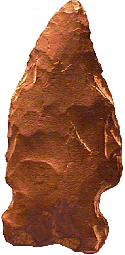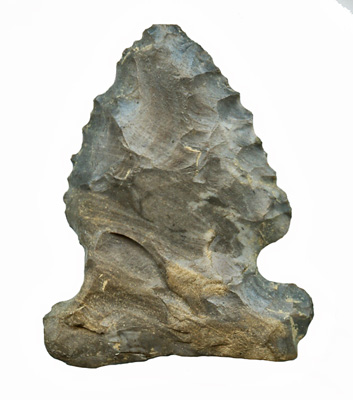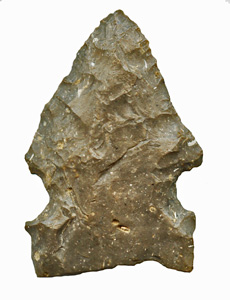





Point Type: OTTER
CREEK
Also See: Accokeek, Archaic Side Notched, Brewerton Side Notched
, Big Sandy, Cache River, Cairo Side Notched, Godar, Graham Cave, Hemphill, Meadowood, Osceola, Oxbow, Raddatz
Location: Northeastern United States
Associated Dates:
6000 - 3500 B.P. - Middle Archaic to Late Archaic
Morphology: Side-Notched
General Description: The Otter Creek type is a medium to large sized, thick, narrow to medium wide side-notched point with square tangs. The blade shape is ovoid to lanceolate, rarely trianguloid in outline with mostly excurvate blade edges. Blade edges can rarely be straight. About 20 percent of specimens will have a asymmetric blade outline which may extend to the basal and tang outline as well. The stem is side notched. The notching seems to have been the final knapping operation which resulted in square tangs. The base in usually concave and less frequently can be straight. The base and tang edges are usually ground smooth and this treatment is often extended to the notches.
The Otter
Creek is found across most of New England with the exception of Maine,
especially west central Vermont near Lake Champlain and mid to southern New
York, northern New Jersey and most of Pennsylvania. Otter Creek points were
typically made from quartzite, slate, some flints or cherts and siltstone. The
Otter Creek size can range from 52 mm to 104 mm in length with the majority
being in the 70 mm to 89 mm range.
The point type was named by William A. Ritchie for points found
by Thomas E. Daniels in the Otter Creek valley, near the hamlet
of Orwell, Addison Co., Vermont.
About The Point Above (left): The average sized Otter Creek point pictured at the top left hand side of this page is 72 mm long, 37 mm wide at the shoulders, and is only 7 mm thick at mid blade just above the notches. The width across the tangs is 35 mm and the concavity of the base is 2.5 mm. The point is made from a blackish and greenish slate or shale that is quite smooth, silky and heavily patinated. The point is highly asymmetrical with one blade edge being excurvate and the other being straight. The excurvate blade edge shows signs of reworking and the blade outline gives the overall impression of the point being once utilized as a blade. The base, tangs or ears and notches are all ground. The basal ears are thinned to 5 mm. The base thickness at the concavity is 4 mm. The blade edges are moderately sharp. Tan dirt still clings to some fracture lines and knapping scars. The blade was found in the corn fields of the historic Robert Treat Farm, borough of Woodmont, Town of Milford, New Haven County, Connecticut. Catalog Number 27-17-V
About The Point Above (center): The small sized Otter Creek point pictured at the top center of this page is 38 mm long, 26 mm wide at the shoulders, and is only 6.3 mm thick at mid blade just above the notches. The width across the tangs is 29 mm and the concavity of the base is 1.9 mm. The point is made from a mottled gray Onondaga chert. The point is heavily patinated. The point is fairly symmetrical however both blade edges have been reworked to the point where the projectile is fairly expended. The excurvate blade edges shows signs of reworking and the blade edges have fine serrations. The base, tangs or ears and notches are all heavily ground. The basal ears are thinned to 3 mm. The base thickness at the concavity is 4.4 mm. The blade edges are moderately sharp. Tan dirt still clings to some fracture lines and knapping scars. The artifact was found in Gowanda, New York. Catalog Number 234-7-BB
About The Point Above (right): The small sized Otter Creek point pictured at the top right hand side of this page is 39 mm long, 27 mm wide at the shoulders, and is only 6.7 mm thick at mid blade just above the notches. The width across the tangs is 26 mm and the concavity of the base is 2.3 mm. The point is made from a mottled gray Onondaga chert which has many cream colored and tan inclusions. The point is patinated. The point is symmetrical however both blade edges have been reworked to the point where the projectile is fairly expended. The blade edges, which are straight to concave show signs of reworking and the blade edges have fine serrations. The base, tangs or ears and notches are all heavily ground. The basal ears are thinned to 3 mm. The base thickness at the concavity is 3 mm and the base and notches are heavily ground smooth. The blade edges are moderately sharp. Tan dirt still clings to some fracture lines and knapping scars. The artifact was found in Gowanda, New York. Catalog Number 482-9-BB
References: Boudreau, Dragoo (b, c, e), Fogelman, Justice (1), Overstreet, Ritchie, Snow
© Copyright 1997 - 2009 LITHICS-Net WWW.LITHICSNET.COM
Use your Browser's BACK Button to return to the LITHICS-Net Index.